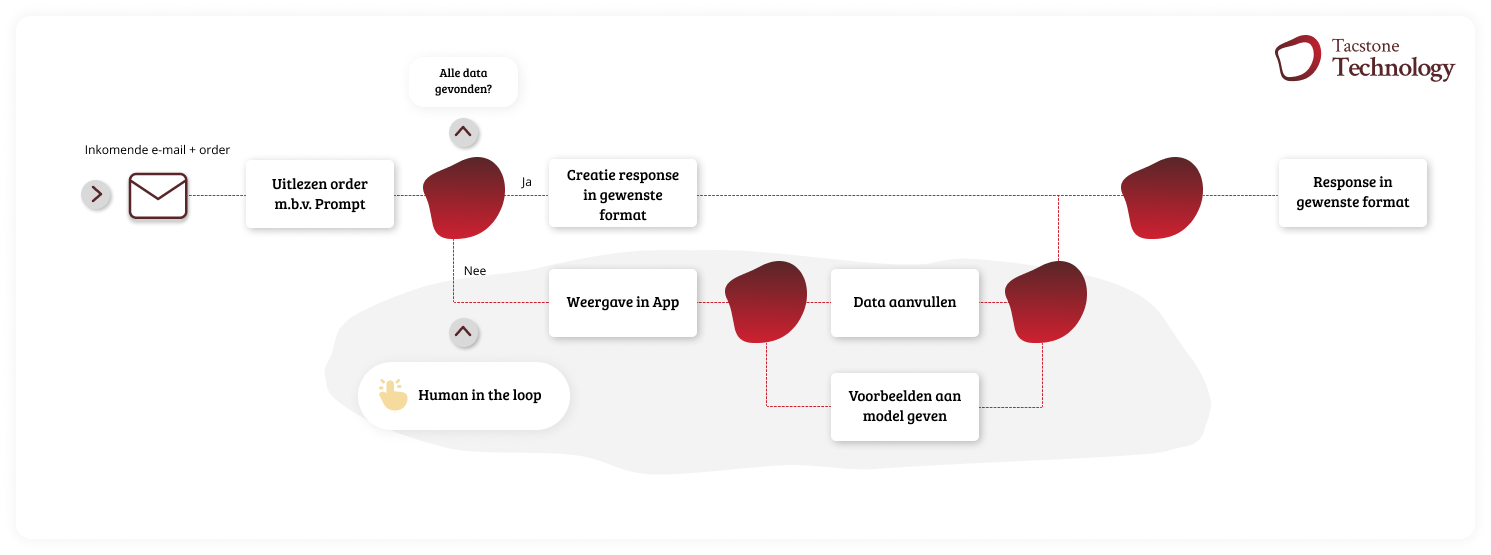AI is smart, but only if you are.
Artificial Intelligence(AI) offers unprecedented opportunities for automating business processes. But the real power of AI only comes into its own when it is properly driven. The key? A good prompt. In this practical example, we show how a smart prompt makes a difference in reading sales orders, a task that previously required a lot of manual work.
Scalability without extra work
One well-formulated prompt can extract data from numerous different document formats without the need for templates.
Efficiency and error reduction
Targeting AI minimizes errors and speeds up processes; from manual hours to automated minutes or even seconds.
Seamless integration with existing systems
AI output can be delivered directly in structured formats such as JSON, ready for processing in ERP systems via APIs.
Reason
Many organizations receive dozens to hundreds of sales orders via e-mail every day, often in PDF or text format. These orders vary widely in formatting and structure, depending on the customer or supplier. Previously, OCR technology combined with templates per supplier was used to extract the correct data. This process was not only time-consuming, but also error-prone and difficult to scale. Any change in a document structure required modification of the template, leading to delays and additional management burden.
The rise of generative AI brought new possibilities. Can this technology be used to automate order reading without fixed formats?
Approach
We started with an analysis of the existing order processing process and identified the bottlenecks: dependence on templates, limited flexibility and high error proneness. We then explored how AI models such as GPT could be used to overcome these constraints.
The core of the approach lay in optimizing the prompt; the work instruction given to the AI. We experimented with different formulations to determine which prompts were most effective in extracting relevant information from unstructured documents. In doing so, we took into account four elements:
- Context: What is the situation or background of the document?
- Targeting: What exactly is the AI supposed to do?
- Format: In what format should the answer be given?
- Language: Clear, concrete and unambiguous.
By combining these elements, we developed a set of prompts that could reliably and reproducibly extract the correct data from disparate documents.
How does it work?
Suppose you receive an order by e-mail: “Dear supplier, we would like to receive 50 pieces of product X (item number 12345) and 20 pieces of product Y (item number 67890). Delivery please June 1 at our warehouse in Amsterdam.” A simple, but poor prompt, might be: “What is in this order?”
The result: a vague, incomplete response that can miss important details.
So what could be a good prompt? “Extract from attached PDF the products ordered, including quantities and item numbers and delivery date. Provide the result as a structured list.” Response:
- Product X – 50 pieces – Item number: 12345
- Product Y – 20 pieces – Item number: 67890
- Delivery date: June 1
This list can be requested in any structure. So here you can also think of JSON, for processing in ERP via API.
The process

What if certain data is not found by AI?
In case of incomplete data reading, the order is offered to a human user via a custom app. This app contains the data needed, which cannot be found.
Through the app, the user can fine-tune the prompt. This is done by returning the correct data via the app to the prompt. This will allow the correct result to be found the next time.
The result
Thanks to the use of smart prompts, the reading of sales orders has been fully automated. This has led to:
- 80% time savings on order processing
- Fewer errors due to human interpretation
- Faster turnaround times and higher customer satisfaction
- Accurate reading of data
- Lower costs by parting with external scanning software
Smart AI prompts: scalable for any document type
Of course, this technology can be used not only for Sales Order, but for many more types of documents. Consider:
✅ Invoices
What to extract: Invoice number, date, supplier, amounts, VAT, payment period.
Application: Automatic posting in financial systems, duplicate invoice control, VAT declaration.
✅ Packing slips / Delivery slips
What to extract: Products delivered, quantities, delivery date, deviations from order.
Application: Automatic matching with purchase orders, update inventory management.
✅ Contracts
What to extract: Parties, term, notice period, obligations, penalty clauses.
Application: Contract management, signaling key dates, risk analysis.
✅ Quotes
What to extract: Products/services offered, prices, conditions, validity.
Application: Comparison of quotations, automatic approval processes, CRM updates.
✅ Emails with customer inquiries or complaints
What to extract: Subject, urgency, customer details, type of request.
Application: Automatic routing to appropriate department, suggested responses, sentiment analysis.
✅ Reports (e.g., quarterly reports, audit reports)
What to get out of them: KPIs, conclusions, recommendations.
Application: summaries for management, dashboards, trend analysis
Why is this important and relevant to you?
With the right prompt, you can quickly and easily deploy AI for practical applications such as order processing, customer service, reporting and more. Because a prompt is scalable, you’ll save time setting up and using it, avoid errors and make your processes smarter.
Want to know more? If so, please contact Bram van Heuvelen.
